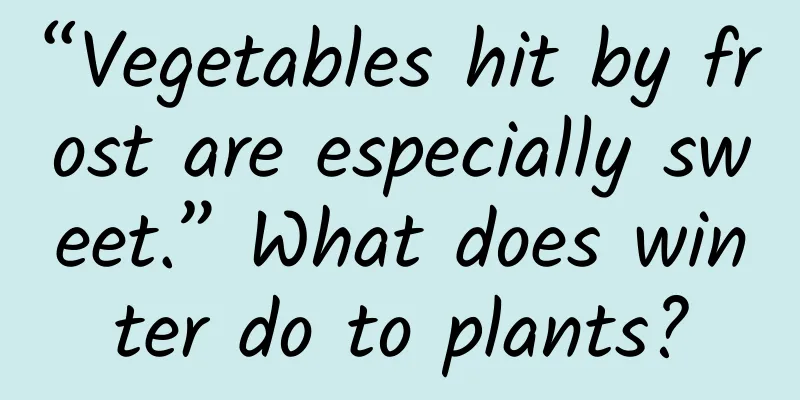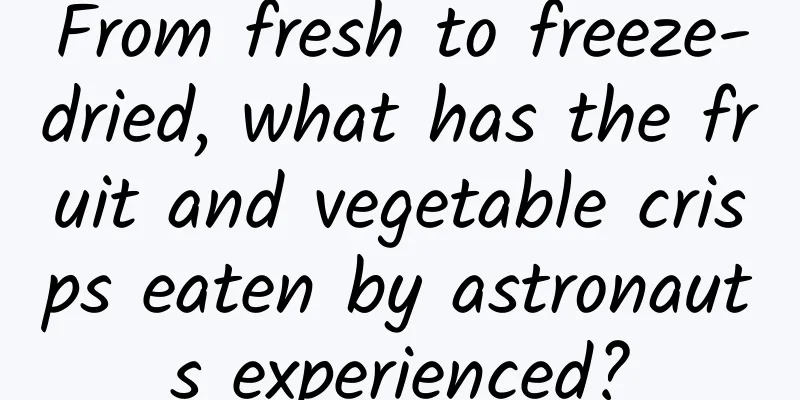“Vegetables hit by frost are especially sweet.” What does winter do to plants?

|
As winter is approaching, people have to worry about adding more clothes to keep warm, but they also get a "limited edition winter" surprise - frost-bitten vegetables. As the saying goes, "frosted vegetables are extra sweet." Are winter vegetables really sweet? What unexpected effects will low temperatures have on plants? 01Why “Frosted vegetables are extra sweet” Our ancestors discovered this phenomenon very early. As early as the Western Han Dynasty, there was a record that "Brassica rapa can be harvested only after enough frost, otherwise it will be bitter." The radish is suitable for harvesting after frost, otherwise it will taste bitter. In the Western Jin Dynasty, the famous writer Lu Ji also concluded that "Bitter radish grows in mountain fields and marshes, and it tastes sweet and crisp after frost." Among the 24 solar terms, Frost Descent is the last solar term in autumn. At this time, the hot weather disappears and most parts of my country can feel the chill. It is from this point in time that some vegetables undergo many changes due to the low temperature. Before the Frost Descent, the temperature is relatively high and vegetables grow rapidly, especially leaves and stems. Due to vigorous metabolism, the sugar content in vegetables is not high at this time. As the temperature drops, the growth rate of vegetables slows down and their metabolic efficiency begins to decrease. At the same time, in order to ensure that the water in their cells does not freeze, vegetables will decompose the starch in their bodies under the action of amylase and convert it into soluble sugars such as sucrose, glucose and fructose, which makes the taste of vegetables more fresh and sweet. Generally speaking, leafy vegetables, such as cabbage, spinach, and choy sum, become sweeter and tastier after being hit by frost. Vegetables commonly found in Sichuan and Chongqing, such as mustard greens, big-headed greens, radishes, and lettuce, also taste better at low temperatures. Local vegetables such as Hongshan red cauliflower in Hubei and Zengcheng late choy sum in Guangdong will see their prices skyrocket after being hit by frost. However, not all vegetables can withstand the test of low temperatures. Some vegetables with poor cold resistance, such as tomatoes, eggplants, beans, peppers, etc., will easily freeze the water in their cells into small ice crystals when they are exposed to low temperatures. After melting, some of this water will be taken away, causing the vegetables to lack water and wilt, and the taste will deteriorate. 02The “Summer After the Cold” of Plants In the face of low temperatures, many plants will "produce" more soluble sugars, which is a "life-saving" method. Humans will also use this characteristic of plants to harvest more sweetness. In nature, plants with high sugar content are often distributed in relatively warm places. Plants "bribe" animals to pollinate or spread seeds by secreting sugar in their flowers or fruits. However, beets grown in northern my country and many temperate regions around the world are heat-sensitive plants. They accumulate a large amount of sucrose in their roots under relatively low temperatures, which not only helps them withstand the cold but also stores nutrients for next year's growth. In the central and northern regions of North America, especially in Canada, there is also a sugar-producing plant that grows, the sugar maple tree. In the fall, sugar maple trees produce large amounts of sugar in their bodies, but the sugar is mainly in the form of starch at this time to withstand the cold and long winter. In the spring, when the sugar maple tree sprouts and needs energy, starch is converted into soluble sugar and transported to the branches. This is like a "start-up capital" to help the branches sprout smoothly. Once the buds themselves begin to grow new leaves for photosynthesis, this transportation process will gradually stop. 03Various cold-resistant skills Making oneself "sweeter" is just one of the many ways plants can survive the cold. Facing the harsh climate, plants have developed various unique ways of survival over millions of years. "Frost kills all the grasses", withering branches and falling leaves are the most common means for plants to deal with the cold. Before the arrival of winter, the change in the length of daylight is a very obvious signal. For deciduous plants, they will prepare for dormancy. Plants will stop growing and begin to synthesize a substance called abscisic acid in aging leaves, mature fruit seeds, stems, roots and other parts. When abscisic acid accumulates in leaves, the leaves begin to turn yellow and fall off. Plants will also reduce their absorption of nutrients and water, and begin to enter a dormant period, waiting for the arrival of spring. Some plants, such as yam, potato, lily, onion, etc., store energy in their roots and stems underground in autumn and winter. Although these plants seem to have withered and died above the surface, they actually have the hope of sprouting again next year under the surface. Of course, there are some plants that are very "introverted". They are unwilling to take a good rest in the winter, but instead prepare for the passing of winter and the coming of spring early - improving their own warming measures so as not to delay normal physiological activities. Gymnosperms such as pine and cypress adopt this strategy, secreting wax on their leaves and trunks. These waxes not only prevent the plant's epidermis from getting wet and losing water, but also prevent heat from being blown away, improving the plant's ability to resist cold. In this way, even in the season of heavy snow, pine and cypress can still remain evergreen. Although winter is bleak, there are still some pollinating animals such as bees and moths active, so some plants choose to bloom in late winter or early spring to avoid fierce competition for pollination. Plum and wintersweet are representatives of this. In order to avoid frostbite, they gradually evolved the skill of "flowering before leaves". Because flowers are more cold-resistant than leaves, these plants can successfully reproduce while minimizing damage caused by low temperatures. However, compared with some alpine plants, these cold-resistant measures are still "conservative". For them, snow, strong winds and cold are commonplace. Instead of passively waiting for the arrival of pollinators, it is better to "actively recruit" them. For example, plants such as the taro and snow lotus will go through a long wait, silently accumulating energy, and then grow huge inflorescences in a very short time. On the inflorescence, there will be many yellow or light green translucent membranous bracts, which are like frosted glass. While resisting the cold wind, they will also let some sunlight in and increase the temperature inside the buds. On a sunny noon, the temperature in the center of the flower bud can even rise by more than 10 degrees Celsius. Such a greenhouse is too attractive for insects in cold environments. As insects go in and out, they also help these plants complete pollination. Although it is freezing cold, plants don’t have to work after all. They rest and recuperate in winter, and eventually they will turn into colorful flowers in spring. With this in mind, shouldn’t you eat more frost-bitten vegetables, wrap yourself tightly in a coat, turn the cold into strength, and encourage yourself to face the cold? Source: Chongqing Science and Technology Museum Author: Quasimodo in the Garden, Master of Agronomy, science popularizer. Review experts: Huang He, Li Chunli, Xu Xiaoping Statement: Except for original content and special notes, some pictures are from the Internet. They are not for commercial purposes and are only used as popular science materials. The copyright belongs to the original authors. If there is any infringement, please contact us to delete them. |
<<: World Stroke Day | Let’s take an adventure into the “secret world” of the brain
Recommend
How do those articles with over 100,000 views come about? Hot articles all follow these 6 principles
How to understand super hit products? For example...
Eight trends in the development of global cloud computing in 2015
In 2014, we saw how cloud computing has driven gr...
How is the advertising fee of Douyin Star Map calculated? Douyin Star Chart Advertising Fee Billing Method Revealed
Self-media and short videos are very popular nowa...
What do penguins drink when they live in an environment without fresh water?
As one of the oldest swimming birds, penguins hav...
Does clean energy have bugs? Too much can’t be stored! Technology coupling may be “fixed”
In September, the "International Forum on Ca...
No appetite, eat some hawthorn to stimulate your appetite? Don't believe these four misunderstandings about eating hawthorn
In this cold winter, holding a string of candied ...
How Cook Kills Android
[[127239]] It's no exaggeration to say that S...
Earning 6 figures a month by writing, my self-media entrepreneurship route!
If you only have one chance to turn things around...
What does full network marketing mean? How can traditional enterprises carry out full-network marketing?
With the rapid development of the Internet, full-...
A complete and effective event planning plan!
Event planning refers to the planning of differen...
The most comprehensive guide to B station information flow advertising is online
BillBill is abbreviated as Bilibili . As the plat...
How to apply for a 400 telephone number?
Nowadays, there are many 400 telephone service pl...
What is the difference between cloud servers, virtual hosting and VPS?
For novice SEO website optimizers, the fastest wa...
Zhuge Laowang's "Douyin Cargo Rapid Breakthrough Camp" Master the correct business logic of Douyin e-commerce
Zhuge Laowang: How to quickly break through the m...
Xiaomi's marketing crisis was cleverly resolved by Alibaba
With the full explosion of social traffic in 2016...









